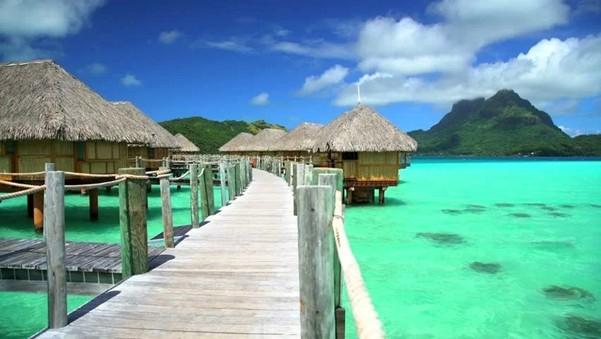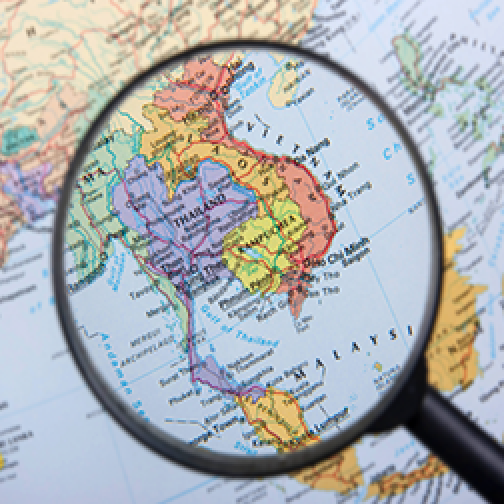Facts and figures
| GDP | $USD 5.81 billions |
| GDP per capita | $USD 20,739 |
| Currency | XPF (CFP Franc ₣) |
| Imports | $USD 2.68 billions |
| Exports | $USD 1.23 billions |
| Main industries | tourism, pearls, agricultural processing |
The ‘Know Your Region’ series is designed to support unit and individual professional military education on the Indo-Pacific region. It’s important for all serving members of our military to have a foundational knowledge of the countries and issues in the Indo-Pacific.
Economic Overview and Challenges
French Polynesia has a developed economy with a large service sector accounting for approximately 75%. The territory’s Gross Domestic Product (GDP) per capita is around $22,000, one of the highest in the Pacific region.
Similar to other Pacific Island economies, French Polynesia relies heavily on tourism, which represents a significant portion of its GDP. The territory’s breathtaking landscapes, crystal-clear lagoons, coral reefs, and iconic overwater bungalows, coupled with a rich cultural heritage, make it a premier global tourist destination. In 2023, over 200,000 international visitors arrived, contributing an estimated $3 billion to the economy. Tourism supports around 60% of the workforce, who are employed by resorts and hotels, restaurants, transportation, outdoor activities, and guided services. Recognising the importance of sustainability, the government has actively promoted eco-tourism, introducing measures to minimise environmental damage while enhancing visitor experiences.

Another industry that contributes to French Polynesia’s economy is pearl farming. Known worldwide for its exquisite black pearls, the territory exports these prized items primarily to Japan, Europe, and the United States.
A relatively new addition to the world of cultured pearls, Tahitian pearl farming began to gain traction during the late 1970s and has expanded rapidly since the turn of the century.
Found throughout French Polynesia, Micronesia, and the Cook Islands, Tahitian pearls are the only naturally occurring black pearls found anywhere in the world, although they come in a variety of colours beside black, making them some of the most colourful pearls. Because of their rarity, they are one of the most sought after and expensive.
Tahitian Pearl farming has provided economic opportunities to thousands of small-scale producers and artisans. In 2023, pearl exports generated around $100 million in revenue.
Fishing remains a crucial sector, with tuna being the most popular fish, harvested for both domestic consumption and export. French Polynesia’s Exclusive Economic Zone (EEZ) is one of the largest in the world at over 5 million square kilometres. It holds vast potential for sustainable fisheries and marine resource development. Subsistence farming also plays a role in the local economy, with key crops including coconuts, taro, breadfruit, pineapples, and mangoes. Despite limited arable land, traditional farming practices ensure these activities remain sustainable and culturally significant.
Manufacturing is limited but steadily evolving, focusing on processing agricultural products, producing artisanal crafts, and assembling small-scale goods. Traditional Polynesian crafts, such as wood carvings, tapa cloth, and woven items not only reflect cultural heritage but also cater to the lucrative tourism market.
Trade Dynamics and Economic Resilience
French Polynesia relies heavily on trade, with imports far exceeding exports (USD $2.2 billion to $174 million in 2022). Key imports include food, fuel, machinery, and construction materials, sourced primarily from France, New Zealand, and the United States. Conversely, exports are concentrated in black pearls, fish products, and handcrafted goods. In 2024, the trade deficit reached $800 million, underlining the territory’s dependence on imports to satisfy local needs. Inflation remains moderate, averaging around 1.5% annually in recent years, reflecting stable pricing for essential goods and services.
French Polynesia’s economy also carries a public debt of approximately 25% of its GDP as of 2023, a manageable level given its reliance on external aid and trade revenues. Economic aid from France plays a vital role in balancing fiscal pressures and supporting essential services. Living standards in the territory are relatively high compared to other Pacific Island nations, with access to healthcare, education, and infrastructure supported by French subsidies.
The COVID-19 pandemic dealt a severe blow to the economy, particularly in tourism, which saw a sharp decline in arrivals. However, strategic marketing campaigns and a global rebound in travel have facilitated a strong recovery. In 2023, the GDP stood at approximately $6 billion, with a growth rate of 3.5% forecast for 2024. Despite these gains, French Polynesia’s small economy remains susceptible to global economic trends and external shocks.
Climate Change and Geographic Challenges
French Polynesia has significant vulnerabilities resulting from climate change. Rising sea levels and more frequent extreme weather events threaten coastal infrastructure, agricultural productivity, and tourism assets. Geographic isolation also exacerbates challenges by increasing transportation costs and limiting economies of scale, which impedes competitiveness and diversification.
To mitigate these risks, the government has enacted policies focused on infrastructure development, renewable energy projects, and trade partnerships. By investing heavily in solar energy and waste management, the government aims to reduce dependence on imported fuels and promote environmental sustainability.
Strategic Development and International Support
French Polynesia’s government, in collaboration with France and international organisations, has implemented targeted programs to foster the territory’s economic resilience. This includes Investments in education, healthcare, and infrastructure with the aim of strengthening human capital and reducing the inequality gap. The territory has also leveraged its EEZ for research and exploitation of marine resources.
France has played a pivotal role in supporting French Polynesia’s economic development with aid accounting for nearly 20% of the territory's GDP. As well as financial aid, France also provides technical assistance, expertise, and training programs to enhance local governance and build capacity across critical sectors. The threat of losing this support has been a major reason why some people are reluctant to support independence.
For more information on French Polynesia’s economy, see resources below:
Articles:
- French Polynesia's Innovation Strategy 2030 – Fāri'ira'a Manihini 2027
- Data balancing acts: The coexistence of offshore tuna and artisanal fisheries in French Polynesia | The Pacific Community
- Economic growth and productivity in French Polynesia: a long-term analysis
- The Islands of Tahiti Publishes a Strategic Roadmap for Inclusive and Sustainable Tourism | Tahiti Tourisme's corporate website
- French Polynesia country brief | Australian Government Department of Foreign Affairs and Trade
Know your region
Know Your Region series gives you a shortcut to understanding other nations in the Indo-Pacific region.









